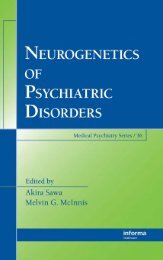Color Atlas of Hematology - Practical Microscopic and Clinical ...
Color Atlas of Hematology - Practical Microscopic and Clinical ...
Color Atlas of Hematology - Practical Microscopic and Clinical ...
- No tags were found...
You also want an ePaper? Increase the reach of your titles
YUMPU automatically turns print PDFs into web optimized ePapers that Google loves.
112Abnormalities <strong>of</strong> the White Cell SeriesReactive Left ShiftA relative left shift in the granulocyte series means less mature forms inexcess <strong>of</strong> 5% b<strong>and</strong> neutrophils; the preceding, less differentiated cell formsare included <strong>and</strong> all transitional forms are taken into account. This leftshift almost always indicates an increase in new cell production in this cellseries. In most cases, it is associated with a raised total leukocyte count.However, since total leukocyte counts are subject to various interferingfactors that can also alter the cell distribution, left shift without leukocytosiscan occur, <strong>and</strong> has no further diagnostic value. At best, if no other explanations<strong>of</strong>fer, a left shift without leukemia can prompt investigation forsplenomegaly, which would have prevented elevation <strong>of</strong> the leukocytecount by increased sequestration <strong>of</strong> leukocytes as in hypersplenism.In evaluating the magnitude <strong>of</strong> a left shift, the basic principle is that themore immature the cell forms, the more rarely they appear; <strong>and</strong> that thereis a continuum starting from segmented granulocytes <strong>and</strong> sometimesreaching as far as myeloblasts. Accordingly, a moderate left shift <strong>of</strong> mediummagnitude may include myelocytes <strong>and</strong> a severe left shift may go asfar as a few promyelocytes <strong>and</strong> (very rarely) myeloblasts, all depending onhow fulminant the triggering process is <strong>and</strong> how responsive the individual.The term “pathological left shift” (for a left shift that includespromyelocytes <strong>and</strong> myeloblasts) is inappropriate, because such observationscan reflect a very active physiological reaction, perhaps following a“leukemoid reaction” with pronounced left shift <strong>and</strong> leukocytosis.Causes <strong>of</strong> Reactive Left ShiftLeft shift occurs regularly in the following situations:➤ Bacterial infections (including miliary tuberculosis),➤ Nonbacterial inflammation (e.g., colitis, pancreatitis, phlebitis, <strong>and</strong>connective tissue diseases)➤ Cell breakdown (e.g., burns, liver failure, hemolysis)Left shift sometimes occurs in the following situations:➤ Infection with fungi, mycoplasm, viruses, or parasites➤ Myocardial or pulmonary infarction➤ Metabolic changes (e.g., pregnancy, acidosis, hyperthyroidism)➤ Phases <strong>of</strong> compensation <strong>and</strong> recuperation (hemorrhages, hemolysis,or after medical or radiological immunosuppression).






